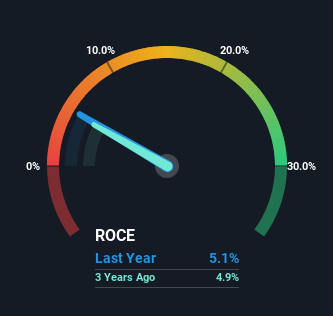- Malaysia
- /
- Electric Utilities
- /
- KLSE:TENAGA
Investors Met With Slowing Returns on Capital At Tenaga Nasional Berhad (KLSE:TENAGA)
If we want to find a potential multi-bagger, often there are underlying trends that can provide clues. Typically, we'll want to notice a trend of growing return on capital employed (ROCE) and alongside that, an expanding base of capital employed. This shows us that it's a compounding machine, able to continually reinvest its earnings back into the business and generate higher returns. However, after investigating Tenaga Nasional Berhad (KLSE:TENAGA), we don't think it's current trends fit the mold of a multi-bagger.
Understanding Return On Capital Employed (ROCE)
Just to clarify if you're unsure, ROCE is a metric for evaluating how much pre-tax income (in percentage terms) a company earns on the capital invested in its business. The formula for this calculation on Tenaga Nasional Berhad is:
Return on Capital Employed = Earnings Before Interest and Tax (EBIT) ÷ (Total Assets - Current Liabilities)
0.051 = RM8.7b ÷ (RM205b - RM34b) (Based on the trailing twelve months to December 2024).
Thus, Tenaga Nasional Berhad has an ROCE of 5.1%. On its own, that's a low figure but it's around the 5.9% average generated by the Electric Utilities industry.
See our latest analysis for Tenaga Nasional Berhad

Above you can see how the current ROCE for Tenaga Nasional Berhad compares to its prior returns on capital, but there's only so much you can tell from the past. If you're interested, you can view the analysts predictions in our free analyst report for Tenaga Nasional Berhad .
The Trend Of ROCE
Over the past five years, Tenaga Nasional Berhad's ROCE and capital employed have both remained mostly flat. Businesses with these traits tend to be mature and steady operations because they're past the growth phase. With that in mind, unless investment picks up again in the future, we wouldn't expect Tenaga Nasional Berhad to be a multi-bagger going forward. This probably explains why Tenaga Nasional Berhad is paying out 60% of its income to shareholders in the form of dividends. Unless businesses have highly compelling growth opportunities, they'll typically return some money to shareholders.
In Conclusion...
In summary, Tenaga Nasional Berhad isn't compounding its earnings but is generating stable returns on the same amount of capital employed. Although the market must be expecting these trends to improve because the stock has gained 41% over the last five years. However, unless these underlying trends turn more positive, we wouldn't get our hopes up too high.
One more thing: We've identified 2 warning signs with Tenaga Nasional Berhad (at least 1 which makes us a bit uncomfortable) , and understanding them would certainly be useful.
If you want to search for solid companies with great earnings, check out this free list of companies with good balance sheets and impressive returns on equity.
Valuation is complex, but we're here to simplify it.
Discover if Tenaga Nasional Berhad might be undervalued or overvalued with our detailed analysis, featuring fair value estimates, potential risks, dividends, insider trades, and its financial condition.
Access Free AnalysisHave feedback on this article? Concerned about the content? Get in touch with us directly. Alternatively, email editorial-team (at) simplywallst.com.
This article by Simply Wall St is general in nature. We provide commentary based on historical data and analyst forecasts only using an unbiased methodology and our articles are not intended to be financial advice. It does not constitute a recommendation to buy or sell any stock, and does not take account of your objectives, or your financial situation. We aim to bring you long-term focused analysis driven by fundamental data. Note that our analysis may not factor in the latest price-sensitive company announcements or qualitative material. Simply Wall St has no position in any stocks mentioned.
About KLSE:TENAGA
Tenaga Nasional Berhad
Engages in the generation, transmission, distribution, and sale of electricity in Malaysia, the United Kingdom, Kuwait, the Republic of Ireland, Australia, and internationally.
Very undervalued with solid track record and pays a dividend.
Market Insights
Community Narratives



